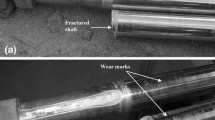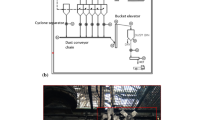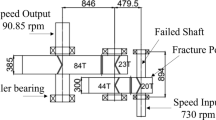Abstract
Detailed failure analysis was carried out on a pump-shaft-assembly containing a step shaft, one single row bearing (SRB) and one double row bearing (DRB). Furthermore, the present failure was associated with a fire incident at a petroleum processing plant. Experimental techniques used included visual inspection, stereoscopy, optical and scanning electron microscopy (SEM), chemical analysis and mechanical testing. Major final failure modes observed included abrasive wear, macro denting, plastic deformation, contact stress fatigue and microstructural and property modifications. Present results indicated the main factor causing assembly failure is the presence of a high-magnitude axial load. Present evidence suggested this extremely high axial load itself to be the result of a pump malfunction—blocking of the pump discharge—which is believed to be the root cause of the present failure. Heat was found to be a main player in the present failure progression. Macro- and microstructural analysis, however, confirmed this heat to be of a frictional origin and not due to the observed fire. This was manifested through the inhomogeneity of the macro- and microstructural modification patterns observed at different locations within the assembly. The fire itself is believed to be due to the exposure of the used lubricant to extremely high temperatures (790–820 °C) beyond its self-igniting temperature range as indicated by the observed microstructural modification and associated softening in the different bearing elements. Some practical recommendations are provided towards the end of this article regarding the present failure.





























Similar content being viewed by others
References
H.S. Kumar, P.S. Pai, Classification of rolling element bearing fault using singular value. J. Quality Maint. Eng. 26(2), 181–197 (2020). https://doi.org/10.1108/JQME-12-2016-0083
A. Vencl, R.A.C. Aleksandar, Diesel engine crankshaft journal bearings failures: case study. Eng. Fail. Anal. 44, 217–228 (2014). https://doi.org/10.1016/j.engfailanal.2014.05.014
I. Salam, A. Tauqir, A.U. Haq, A.Q. Khan, An air crash due to fatigue failure of a ball bearing. Eng. Fail. Anal. 5(4), 261–269 (1998)
A. Hajnayeb, S.E. Khadem, M.H. Moradi, Design and implementation of an automatic condition-monitoring expert system for ball-bearing fault detection. Ind. Lubr. Tribol. (2008). https://doi.org/10.1108/00368790810858395
N. Menasri, M. Zaoui, A. Bouchoucha, Detection and localization of isolated wear bearing faults of rotating machinery by spectral analysis. World J. Eng. 10(6), 565–572 (2013)
B. Al-Najjar, W. Wang, A conceptual model for fault detection and decision making for rolling element bearings in paper mills. J. Qual. Maint. Eng. 7(3), 192–206 (2001)
J. Wu et al., Design a degradation condition monitoring system scheme for rolling bearing using EMD and PCA. Ind. Manage. Data Syst. 117(4), 713–728 (2017)
P. Jayaswal, S.N. Verma, A.K. Wadhwani, Application of ANN, fuzzy logic and wavelet transform in machine fault diagnosis using vibration signal analysis. J. Quality Maint. Eng. 16(2), 190–213 (2010). https://doi.org/10.1108/13552511011048922
ASTM D8128-17, Standard Guide For Monitoring Failure Mode Progression In Industrial Applications With Rolling Element Ball Type Bearings
ISO 19283:2020, Condition monitoring and diagnostics of machines—Hydroelectric generating units
ASTM D5185-18, Standard Test Method for Multi-Element Determination of Used and Unused Lubricating Oils and Base Oils by Inductively Coupled Plasma Atomic Emission Spectrometry (ICP-AES)
A. Davies, Handbook of Condition Monitoring, 1st edn. (Springer Science Business Media; Chapman & Hall, Dordrecht, 1998)
R.B. Randall, Vibration Based Condition Monitoring, 1st edn. (John Wiley & Sons Ltd, New York, 2011)
Li. Cui, A new fatigue damage accumulation rating life model of ball bearings under vibration load. Ind. Lubr. Tribol. 72(10), 1205–1215 (2020). https://doi.org/10.1108/ILT-05-2019-0180
X.Q. Jin, X.M. Li, H. Chen, Fault diagnosis method of helicopter swash-plate bearing based on neural network. J. Najing Univ. Aeronaut. Astronaut. 28(2), 230–237 (2016)
E.G. Ellis, The lubrication of bearings at high temperatures. Ind. Lubr. Tribol. 12(9), 16–23 (1960)
I.M. Jamadar, D. Vakharia, Correlation of base oil viscosity in grease with vibration severity of damaged rolling bearings. Ind. Lubr. Tribol. 70(2), 264–272 (2018). https://doi.org/10.1108/ILT-04-2016-0078
Cases of Machinery Failure, Chapter 2, in: Samuel, A.E. The Winning Line: A Forensic Engineer's Casebook. (Springer Science and Business Media, 2007)
D. Scott, Bearing failures diagnosis and investigation. Wear. 25(2), 199–213 (1973)
SKF publication 14219/2 Bearing damage and failure analysis
Y. Sevik, E. Durak, Investigation of fretting wear in journal bearings. Ind. Lubr. Tribol. 68(4), 466–475 (2016). https://doi.org/10.1108/ILT-11-2015-0171
Z. Huang, Q. Li, Y. Zhou, S. Jing, Y. Ma, W. Hu, Y. Fan, Experimental research on the surface strengthening technology of roller cone bit bearing based on the failure analysis. Eng. Fail. Anal. 29, 12–26 (2013). https://doi.org/10.1016/j.engfailanal.2012.08.018
F.K. Geitner, H.P. Bloch, Chapter 3—machinery component failure analysis. In Machinery Failure Analysis and Troubleshooting, 4th edn. (Butterworth-Heinemann, Oxford, 2012) pp. 87–293
H. Peng, H. Zhang, L. Shangguan, Y. Fan, Review of tribological failure analysis and lubrication technology research of wind power bearings. Polymers. 14(15), 3041 (2022)
W. Bian, Z. Wang, J. Yuan, W. Xu, Thermo-mechanical analysis of angular contact ball bearing. J. Mech. Sci. Technol. 30(1) (2016)
Z. Liu, W. Chen, D. Li, W. Zhang, Theoretical analysis and experimental study on thermal stability of high-speed motorized spindle. Ind. Lubr. Tribol. (2017). https://doi.org/10.1108/ILT-04-2016-0091
W. Zhang, W. Chen, Z. Liu, Experimental study on thermal effect of tilted roller pairs in rolling/sliding contacts. Ind. Lubr. Tribol. 69(2), 225–233 (2017). https://doi.org/10.1108/ILT-01-2016-0005
S.-M. Kim, S.-K. Lee, K.-J. Lee, Effect of bearing surroundings on the high-speed spindle-bearing compliance. Int. J. Adv. Manuf. Technol. 19, 551–557 (2002)
B. Li, J. Sun, H. Wang, X. Zhang, On the lubrication performance of journal bearing coupled with the axial movement of journal. Ind. Lubr. Tribol. (2022). https://doi.org/10.1108/ILT-12-2021-0476
W.J. Bartz, The influence of lubricants on failures of bearings and gears. Tribol. Int. 9(5), 213–224 (1976)
M. Kushwaha, H. Rahnejat, R. Gohar, Aligned and misaligned contacts of rollers to races in elastohydrodynamic finite line conjunctions. Proc. Inst. Mech. Eng. Part C J. Mech. Eng. Sci. 216(11), 1051–1070 (2002). https://doi.org/10.1243/095440602761609434
T. Holkup, H. Cao, P. Kolář, Y. Altintas, J. Zelený, Thermo-mechanical model of spindles. CIRP Ann. 59(1), 365–368 (2010). https://doi.org/10.1016/j.cirp.2010.03.021
ISO 15243:2017: Rolling bearings—Damage and failures—Terms, characteristics and causes
X.-L. Xu, Z.-W. Yu, Failure analysis of tapered roller bearing inner rings used in heavy truck. Eng. Fail. Anal. 111, 104474 (2020). https://doi.org/10.1016/j.engfailanal.2020.104474
M.S. Patil, J. Mathew, P.K. Rajendrakumar, Experimental studies using response surface methodology for condition monitoring of ball bearings. J. Tribol. 132(4), 1–6 (2010)
D.J. Wulpi, Understanding How Components Fail (ASM International, 2013)
F. Steinweg, A. Mikitisin, T. Janitzky, S. Richter, T.E. Weirich, J. Mayer, C. Broeckmann, Influence of additive-derived reaction layers on white etching crack failure of SAE 52100 bearing steel under rolling contact loading. Tribol. Int. (2023). https://doi.org/10.1016/j.triboint.2023.108239
K. Nikolic, V.M. Ferreira, L. Malet, T. Depover, K. Verbeken, R.H. Petrov, Uncovering the white etching area and crack formation mechanism in bearing steel. Mater. Charact. 197, 112659 (2023). https://doi.org/10.1016/j.matchar.2023.112659
B. Gould, N.G. Demas, A.C. Greco, The influence of steel microstructure and inclusion characteristics on the formation of premature bearing failures with microstructural alterations. Mater. Sci. Eng. A. 751, 237–245 (2019). https://doi.org/10.1016/j.msea.2019.02.084
H.N. Kaufman, Classification of Bearing Damage, in Interpreting Service Damage in Rolling Type Bearings—A Manual on Ball and Roller Bearing Damage. (American Society for Lubrication Engineers, Chicago, 1958)
R.L. Widner, Failures of rolling-element bearings, In: ASM Handbook Volume 11, Failure Analysis and Prevention (ASM International, Materials Park, 2002)
R.A. Hobbs, Rolling contact bearings. Ind. Lubr. Tribol. 33(3), 100–105 (1981). https://doi.org/10.1108/eb053226
O. Müştak, Characterization of SAE 52100 Bearing Steel for Finite Element Simulation of Through-Hardening Process, MSc. Thesis, 2014, Middle East Technical University, Istanbul, Turkey (2014)
H. Li, H. Liu, Y. Liu, S. Qi, F. Wang, On the dynamic characteristics of ball bearing with cage broken. Ind. Lubr. Tribol. 72(7), 881–886 (2020). https://doi.org/10.1108/ILT-01-2020-0042
R.A.E. Wood, Rolling bearing cages. Tribology. 5(1), 14–21 (1972). https://doi.org/10.1016/0041-2678(72)90181-9
R.P. Todorov, K.G. Khristov, Widmanstatten Structure Of Carbon Steels. Met. Sci. Heat Treat. 46, 49–53 (2010). https://doi.org/10.1023/B:MSAT.0000029601.58461.bd
S.-S. Li, Y. Shen, Q. He, Study of the thermal influence on the dynamic characteristics of the motorized spindle system. Adv. Manuf. 4, 355–362 (2016). https://doi.org/10.1007/s40436-016-0158-1
M. Blödt, P. Granjon, B. Raison, J. Regnier, Mechanical fault detection in induction motor drives through stator current monitoring-Theory and application examples. In Fault Detection, (2010) pp. 451–488 https://hal.science/hal-00485734.
https://www.sintechpumps.com/pumps/centrifugal-pumps/worry-about-axial-thrust-problems/.
R.L. Widner, W.E. Littmann, Bearing Damage Analysis, NBS 423. (National Bureau of Standards, Washington, 1976)
ISO 12925-1:2018: Lubricants, Industrial Oils and Related Products (Class L)—Family C (Gears)—Part 1: Specifications for Lubricants for Enclosed Gear Systems.
M.A.M. Siregar, Y. Nugroho, Study on auto-ignition behavior of lubricating oil in a cone calorimeter. Appl. Mech. Mater. 493, 161–166 (2014). https://doi.org/10.4028/www.scientific.net/AMM.493.161
Acknowledgments
The authors would like to express their sincere gratitude for SKF, Sven Wingquists gata 2, 415 50 Gothenburg, Sweden for generously granting permission to parts of their literature in this article.
Author information
Authors and Affiliations
Corresponding author
Additional information
Publisher's Note
Springer Nature remains neutral with regard to jurisdictional claims in published maps and institutional affiliations.
Rights and permissions
Springer Nature or its licensor (e.g. a society or other partner) holds exclusive rights to this article under a publishing agreement with the author(s) or other rightsholder(s); author self-archiving of the accepted manuscript version of this article is solely governed by the terms of such publishing agreement and applicable law.
About this article
Cite this article
Abdul Jawwad, A.K., Hasanain, B., Aldamak, A. et al. Utilizing Macro- and Microstructural Characterization in Root Cause Analysis (RCA) of a Shaft-Bearing Assembly Failure. J Fail. Anal. and Preven. 23, 948–969 (2023). https://doi.org/10.1007/s11668-023-01650-7
Received:
Revised:
Accepted:
Published:
Issue Date:
DOI: https://doi.org/10.1007/s11668-023-01650-7





